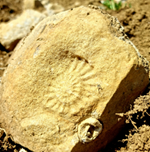Fossil of Pre-Historic Madtsoiidae Snake Discovered in Ladakh
- 17 May 2022
Scientists have discovered the fossil of a Madtsoiidae snake in the Himalayan mountains in Ladakh, which sheds fresh light on the prevalence and existence of this rare serpent species in the Indian subcontinent.

- Madtsoiidae is an extinct group of medium-sized to gigantic snakes, firstly appeared during the later part of the Cretaceous period, that began 145 million years ago and ended 66 million years ago. They are thought to grow up to 30 feet in length.
- Research by scientists indicates their prevalence in the Indian subcontinent for a much longer time than previously thought. Also, global climatic shifts and the prominent biotic reorganisation across the Eocene-Oligocene boundary did not cause the extinction of this important group of snakes in India.
| Eocene–Oligocene Extinct Event
|
- Madtsoiidae were mostly found in the Gondwanan landmasses, an ancient supercontinent that broke up about 180 million years ago.
- From fossil records, the whole group disappeared in the mid-Paleogene period, ranging between 66 million to 23 million years ago, across most Gondwanan continents except for Australia where it survived with its last known classification of Wonambi till the late Pleistocene period from 2.6 million to 11,700 years ago.




